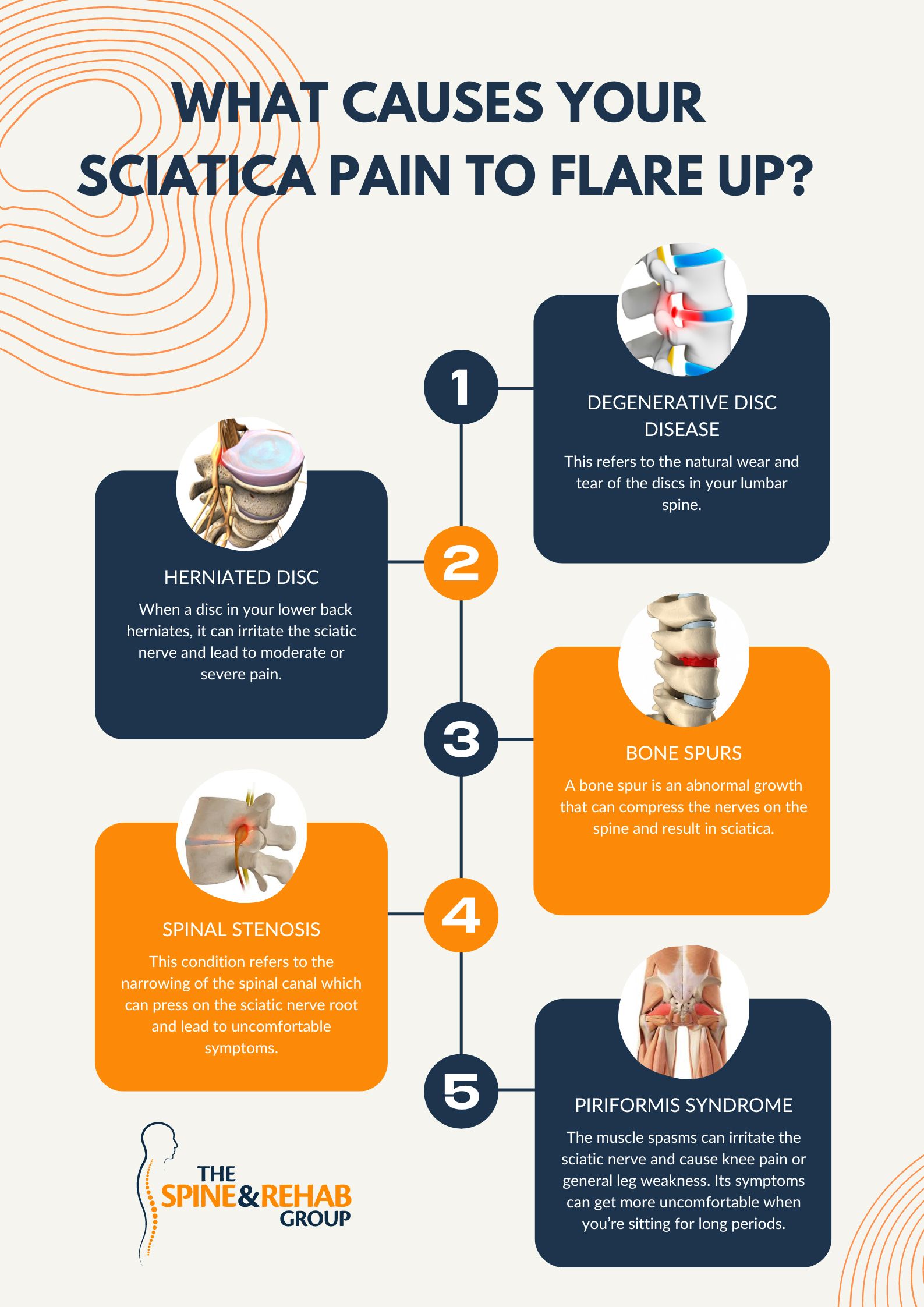 OUR LOCATIONS
Call to book 201.523.9590
OUR LOCATIONS
Call to book 201.523.9590
 OUR LOCATIONS
Call to book 201.523.9590
OUR LOCATIONS
Call to book 201.523.9590

It’s never easy to live with chronic pain, especially if it’s originating from your spinal cord. Most spinal disorders such as sciatica can have symptoms of burning, stabbing, or debilitating pain which can make it difficult to do even the simplest of activities like sitting. If your job requires you to sit for long hours or even if you’re just staying at home, you need to know the proper position that can help reduce your sciatica pain.
So what’s the ideal sitting position that can alleviate your sciatic nerve pain condition? Sciatica sufferers can try several positions to minimize the pressure on the affected sciatic nerve. You can sit comfortably by keeping your feet flat on the floor, sitting with your back all the way to the rest of the chair, maintaining an open hip angle, and using a lumbar support or seat cushion. Some patients also find that sitting with crossed legs can help improve sciatica pain symptoms.
Sciatic nerve pain is not an uncommon condition, and about 10% to 40% of adults can experience this disorder in their life. Patients with sciatica often complain about having moderate to severe lower back pain with numbness, weakness, or tingling that can radiate down to the buttocks, legs, and calves.
Unfortunately, the symptoms of sciatica are most commonly felt whenever you’re sitting. This simple action applies excess pressure to the discs or compressed nerves in your spine which results in excruciating lower back pain that can extend to your extremities.
While there are some medications that can ease your sciatica condition, the best way to naturally relieve your symptoms is by practicing good posture when sitting. Here are some of the recommended sitting positions that you can try for sciatica pain relief:
When you have to sit down for hours, you can make yourself comfortable by sitting up straight with your back resting on the chair. Keep your shoulders relaxed and avoid bending or hunching forward to prevent overexerting your lumbar spine. This position can also help distribute your weight more evenly throughout your body to avoid any unwanted pressure on your sciatic nerve.
You can also reduce the tension on your affected leg by ensuring that you’re seated with both feet on the ground. Leaving your feet dangling in the air may cause gravity to pull you forward and it will affect your overall balance and put pressure on your core muscles.
If you can adjust your desk chair, it’s also recommended to set them at a comfortable height where you can place your feet firmly on the floor. You can also use a footrest to provide stable support and keep blood circulation in your leg muscles.
Contrary to the traditional way of sitting with knees and hips at a 90-degree, it’s better to have a wider or more open hip angle for your sciatica pain. When your knees and hips are perpendicular, they can increase tightness in your hip flexors and pelvis which may aggravate your sciatica pain.
To help relieve your sciatic nerve symptoms, you can position your hips at more than 90 degrees to relax your muscles and hip flexors. This can also help lessen the compression or irritation of your sciatic nerve. You can do this by increasing the height of your seat, using a cushion, or keeping your feet tucked underneath the chair to provide a stretch to your muscles.
Sciatica usually affects only one side of the body so it’s typical to experience leg pain one at a time. You can also assume a cross-legged sitting position to minimize the discomfort on the affected side. You can find some relief by raising your pained leg over the other, and doing so may release some of the tension from the sciatic nerve. It may also help stretch the piriformis muscle which directly affects the nerve.
You can also support your lower spine by placing a comfortable support pillow on your chair. This will help correct your poor posture and support the natural inward curve of your lower back. Additionally, using lumbar support can help you relax in your chair while keeping your mind off your sciatic pain. If you don’t have a cushion, you can also do makeshift lumbar support with a rolled towel.
The sciatic nerve is the longest nerve that extends from the bottom of your spine to the pelvis, buttocks, thighs, and legs. It’s the most important nerve that’s responsible for movements such as walking, standing, and running. But when you’re seated, the majority of your body weight is put on the lower back which compresses the spinal discs and applies pressure on the sciatic nerve roots.
Direct injuries or damages to the sciatic nerve don’t usually happen, but there are related medical conditions that can cause the symptoms to show. Some of the usual sources of sciatica are:
Aside from these disorders, there are other factors that contribute to your sciatica nerve pain. It’s believed that this condition is more common among older adults, overweight patients, and inactive or sedentary individuals. Having a pre-existing chronic low back pain condition or spine disorder can also put you more at risk for sciatica.

In addition to having a good sitting posture, there are other things you can do to remedy your sciatica pain. This can include doing at-home therapy with an ice pack or hot compress, exercising, taking frequent standing breaks, and buying an ergonomic chair.
One of the best natural remedies for sciatica pain is temperature therapy. This involves the use of either a cold or hot compress on your lower back to provide temporary relief. Applying ice can reduce the inflammation in the affected area, while heat therapy stimulates blood flow and promotes faster healing.
If you want to prevent sciatica, you should avoid prolonged sitting and instead get moving to stretch your muscles and keep your lumbar spine healthy. You may think it’s somewhat contradictory to exercise if you’re experiencing uncomfortable leg pain, but there are gentle stretches that you can do which won’t harm your sciatic nerve. You can definitely do light yoga positions and some hamstring stretches and sciatic nerve glide exercises.
Whether you’re working at home or resting on your couch, you should remember to take standing breaks and stretch your legs every 15 to 30 minutes. You should stand up once you feel unbearable pain in your lower back. You should also change your sitting posture every 20 minutes to alleviate the pressure on your lumbar spine.
For low back pain and sciatica sufferers, an ergonomic chair is definitely worth the investment that can provide sitting comfort in the long run. It helps you maintain a proper posture as you work while reducing pressure on the spine and nerves to reduce your pain. You may also consider buying a recliner chair that can support your back muscles and allow you to lean back and rest comfortably.
If your symptoms aren’t improving with self-care remedies and changing your sitting posture, you may have to schedule a visit to your primary care doctor or spine specialist. They will perform some medical tests to get an accurate diagnosis for your condition and recommend a treatment plan. Here are some of the common treatments that can help with sciatica pain:
So, to recover from this problem quickly, get active and follow the advice of a good sciatica specialist near me. You can meet this specialist via the internet.
Sciatica isn’t a completely rare condition, but the people who are affected by it can experience discomfort in their daily life. One way to relieve this disorder is by maintaining a good sitting posture. However, if you experience lasting pain, it may be a sign that you need a more comprehensive sciatica treatment plan.
At The Spine and Rehab Group, we have expert doctors and physical therapists who can help minimize your symptoms and get you back to optimal health. We have extensive experience in the best practices and therapies for relieving all kinds of acute and chronic pain. Call us today to request a consultation and discuss your sciatica concerns.



